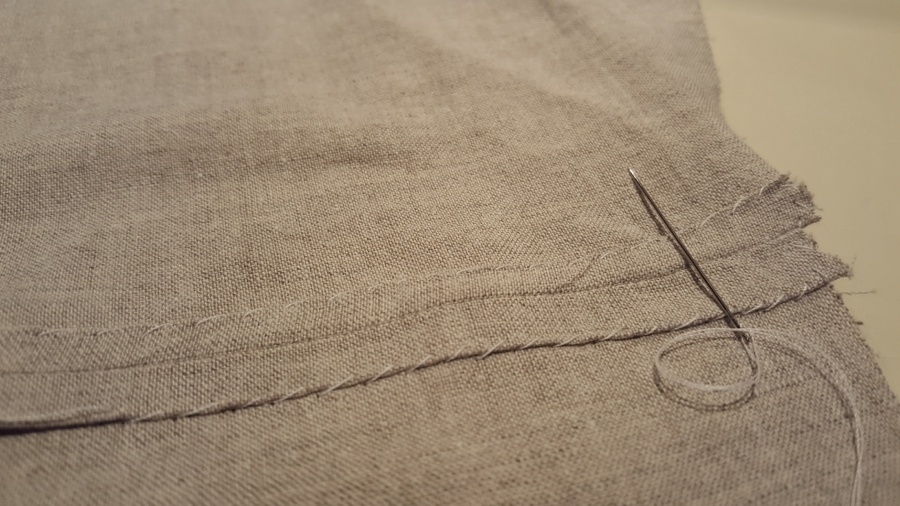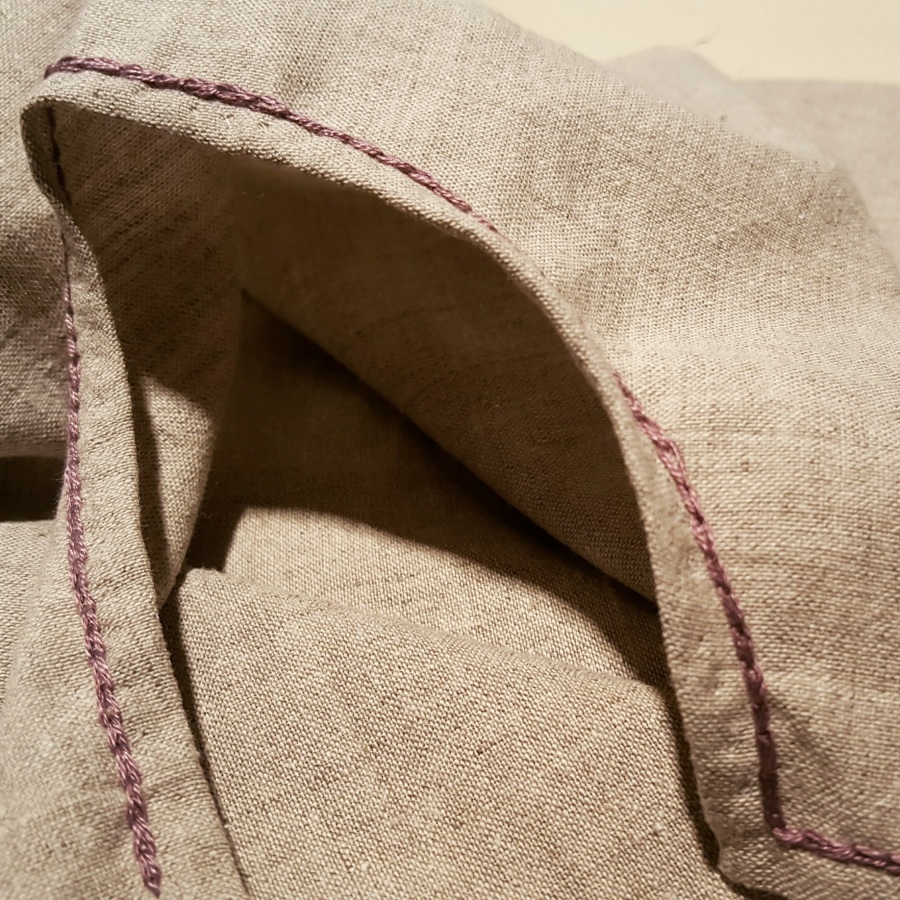For various reasons (mostly obstinance) I don’t do a lot of 9th-11th century Scandinavian stuff (hereinafter “Viking”). However, my sister (who lives far away) is coming with me to an east coast coronation in April and needs something to wear. She found a photo of one of Savelyeva Ekaterina‘s beautiful (if slightly fantastical) outfits on line and, as that was a step down from the pearled Russian gown of opulence she initially proposed, I agreed. This post will be updated as I continue to work on the dress. Read on below the cut.
Ingredients
- 4 yards of natural linen/cotton blend (selected because it’s $2/yard cheaper than 100% linen and she’s not full-time SCA)
- 3 yards of “Evergreen” linen (from fabrics-store.com)
- 2 yards of “Vinyard” linen (from fabrics-store.com)
- Cotton embroidery thread (DMC 3801)
Research
We don’t know what the early medieval Scandinavian women called their garments, the proposed historical name for the apron-dress is Old Norse (ON) smokkr. The under-dress may have been a serk in ON. Because this is meant to be a basic introduction, I’m going to use the English term “under-dress” for the long-sleeved garment worn under the over dress and “apron-dress” (German hängerock) for the sleeveless garment worn over the under-dress.
The sister wanted a fitted apron-dress that would be more pleasing to the modern aesthetic. Because the only fitted Viking apron-dress I’m familiar with is the 10th century Danish/German fragments from Hedeby/Haithabu (ON Heiðabýr), that’s where I went for my research and planning. (Regarding the / marks, the fragment was found in the modern German town of Haithabu, in Schleswig-Holstein. For reasons we don’t need to get into right now, that part of Schleswig-Holstein used to belong to Denmark and the Danish pronunciation of the town name [ˈheːð̩byːˀ], gets transliterated in English as Hedeby, because we find the Danish [ð̩] difficult.)
Inga Hägg did the majority of the research on the Hedeby/Haithabu finds. She published two major works on the finds, Die Textilfunde aus dem Hafen von Haithabu (The textile finds from the harbor of Haithabu) (Berichte über die ausgrabungen in Haithabu, Bericht 20. Neumünster: Karl Wachholz Verlag, 1984) and Textilfunde aus der Siedlung und aus den Gräbern von Haithabu (Textile finds from the settlement and graves from Haithabu) (Berichte über die ausgrabungen in Haithabu, Bericht 29. Neumünster: Karl Wachholz Verlag, 1991).
Apron-Dress
The Haitabu/Hedeby fragments interpreted as belonging to an apron-dress are small. The first piece, Fragment A, is just under 12″ long and 6.25″, widening to 9″, across (a little bigger than a standard piece of printer paper). The second piece, Fragment B, is 4.75″ by just under 10″. The fragments were found in the caulking of a ship, meaning they are devoid of any of the grave goods that we would typically use to identify more about the garment’s owner. They are made of a fine napped brown wool and Fragment A has a piece of braid couched over a dart.


The couched cord and dart are visible along the left side of the drawing of Fragment A. This dart has led to the interpretation that the apron-dress was fitted to the wearer’s body. Because the Hedeby/Haithabu fragments are just that, fragments, its impossible to say whether or not that interpretation is correct. Based on how the top hem is folded, the dart appears sewn on the outside of the garment (rather than the inside, as with modern garments). Over the dart a six strand braid has been stitched, reaching to the top of the garment (further than the dart).
A graveyard at Hedeby/Haithabu resulted in a number of other small finds. Of the graves examined, 16 contained tortoise broaches. The majority of the textiles in these graves had degraded, but fine linen loops were found in the tortoise broaches.
The top edge of Fragment A has been folded over to the opposite side as the dart and sewn down with a complex braided stitch called an “Ösenstich”. Either this stitching or the dart would have been visible on the outside of the garment, but not both.
The Hedeby/Haithabu finds give no evidence for the length of the apron-dress.
Under-dress
The graves of Hedeby/Haithabu also turned up linen fragments that Hägg interprets as possibly pieces of an under-dress. As there are significantly more fragments than with the Apron-dress, I’m not going to try and summarize the information here. Instead, I encourage you to read Hilde Thunem’s discussion here.
Some generalities: Fragments were found various linen weaves. A higher level of tailoring was indicated on some of the fragments, including a complex pieced sleeve. The colors include red, blue, and natural, and the patterns of the textiles include a woven-in ridged pattern and checks. No fragments were large enough to indicate the cut of a whole under-dress.
Making the Thing(s)
So, having read up on Hedeby/Haithabu, I dumped most of that out the window and made a garment that would be simple enough to complete within the week that the Sister would be visiting from the other coast.
I cut the under-dress according to Vigdis vestfirzka’s pattern. I’ve used her pattern a number of times before and find it easy to fit and use. I augmented the pattern by adding gores to the center front and back, to give the skirt a bit more volume. I also had to piece the sleeve together at the elbow, because I didn’t have a piece of fabric big enough. The hem of the under-dress reaches to the floor.
After the initial fitting, I had to go back and and gussets and a spacer of fabric to the sleeve to make the fit more comfortable. All the piecing in the sleeve was done by hand with the seams rolled flat and stitched down with a whip stitch.

I finished the keyhole neckline by hand and did a small line of chain stitch, to add a bit of color.

A matching line of embroidery was added to the end of the sleeves.
I had lots of fabric for the apron-dress so I cut that using the simplest pattern I could (drawing the shape and cutting it out). I cut three panels and one gore and sewed it together so that the gore will be in the center back. I plan to retrofit the apron-dress with appliqued braid like the Hedeby/Haithabu garment fragment (so that I can pretend that I did the research with a purpose). But it’s important to note that this cutting pattern isn’t based on any historical evidence, it was just easy.
The sister also wanted a shawl, that was cut out of a lighter shade of green in an exaggerated D shape. It drapes over her shoulders and ripples very elegantly.
At this point, the whole ensemble looks like this.

Things I need to do to complete the outfit
- Finish the fitting (in the picture you can make out safety pins in the seams, I need to bring it in A LOT).
- Finish the hem and top of the apron-dress.
- Add straps and loops to the apron-dress.
- Finish the hem of the under-dress.
- Make the shawl prettier (the Sister would like it stamped in a gold pattern, I think that will look swank).
- Finish the edges of the shawl.
- Applique some thing to the top of the apron dress so that it looks more fancy.
- Sort out some bead swag.
I ordered a pair of broaches from Raymond’s Quiet Press. The broaches I ordered are the “bear-head” type usually associated with Swedish and Gotlandic finds and the graves at Hedeby/Haithabu do not show any evidence of their use. However, bears.
Sources
http://urd.priv.no/viking/smokkr.html
http://urd.priv.no/viking/serk.html
Ewing, Thor. Viking clothing. Stroud: Tempus, 2006.
https://www.cs.vassar.edu/~capriest/viktunic.html
Click to access hedeby-smokkr-class-handout.pdf
http://members.ozemail.com.au/~chrisandpeter/hangerock/hangerock.htm
http://www.shelaghlewins.com/reenactment/hedeby_apron/hedeby_apron.htm

“However…bears.”
Lol.
LikeLike